Want to start recording acoustic guitars at home but you’re on a relatively low budget? We have you covered with our list of nine of the best microphones for recording acoustic guitars, all of which are under £100!
These budget-friendly studio mics prove that you don’t have to spend a fortune to enjoy high-quality recordings. Our industry-standard options from the likes of Shure and AKG provide exceptional value for way under the £100 price tag.
We’ve already discussed the best microphones for recording acoustic guitars for those on a higher budget in a previous article. This time, we’ll delve into the lower end of the price spectrum, so those who are just starting out can create world-class demos and acoustic guitar recordings on a budget.
What type of microphone do I need?
Essentially, you’ll need a condenser microphone with a cardioid polar pattern, preferably a side-address mic.
Here’s why:
- Condenser microphones are more sensitive to all frequencies, ensuring you get the subtle nuances of your tonewood, chord changes, and resonance appearing in the mix
- Cardioid polar patterns reject off-axis sound (the sounds around and behind the mic) so you only record the guitar – not the ticking clock across the room!
- Side-address can get closer to the guitar and often utilise a larger diaphragm for greater sonic detail
These are not hard and fast rules but are some of the criteria we have taken into account when choosing these budget-friendly microphones.
USB or XLR?
This comes down to personal preference.
If you don’t already have an audio interface and you don’t want to buy one – get a USB mic. If you have an audio interface, XLR is often a better option.
Condenser microphones need 48v phantom power to work – which they get through an audio interface. If you don’t have this, you won’t hear anything when recording.
In general, a USB microphone is a cheaper alternative. However, it may limit you further down the line as you might not be able to plug it into an audio interface.
We’ve included a mix of both USB and XLR mics in this guide.
The microphones…
We’ll look at industry-standard options as well as relative newcomers in the industry, taking into account USB or XLR connectivity, cardioid polar patterns, and those within the condenser mic category.
1. Shure PGA57 Cardioid Dynamic Instrument Microphone with XLR Cable
 We start our list with the Shure PGA57 which is incredible value for money at way under £100.
We start our list with the Shure PGA57 which is incredible value for money at way under £100.
Although it’s been designed to handle louder instruments, the PGA57 makes our list thanks to its frequency response of 70Hz – 15kHz. This helps to reduce the bottom-end “boom” that acoustic recordings can suffer from.
The frequency response also provides a touch of extra definition thanks to a presence boost at 6kHz, meaning you can really hear the nuances of your playing and the qualities of your acoustic guitar without the messy bass frequencies.
A cardioid polar pattern then rejects all the unwanted noise around the mic, making it perfect for capturing vocals too.
The Shure PGA57 comes with an XLR Cable, so there’s less stuff to buy. Better still, the quality housing and mesh grille that Shure are so renowned for provides peace of mind that your microphone will withstand the most rigorous of recording schedules.
It’s easily one of the most versatile mics and one of the best for recording acoustic guitar for under £100.
If you want a mic you’ll probably never have to upgrade – start here.
Is this an XLR or USB mic?
It’s an XLR – you’ll need an XLR cable (it comes with one!) and an audio interface
Shop now | Shure PGA57 Cardioid Dynamic Instrument Microphone with XLR Cable
2. Shure MOTIV MV5 USB Microphone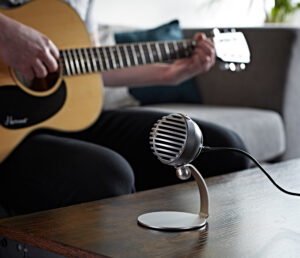
Not everyone wants to use an audio interface, nor has the time to set one up and learn how to use it. And so, this is where the Shure MOTIV MV5 comes in handy!
This USB condenser mic provides incredibly detailed recording for under £100, allowing you to plug straight into your Mac, PC, iPhone, iPad, or iPod without the need for an interface.
Just download the free ShurePlus MOTIV app, connect your device via the included cables, and hook up headphones to the built-in headphone output. You’ll be ready to create acoustic guitar masterpieces.
This makes our list because it’s a detailed condenser microphone with a cardioid polar pattern which rejects all off-axis noise. The adjustable frequency response allows you to dial in anywhere between 20Hz – 20kHz, so you can have as much detail as you want.
Best of all, the three quick modes (vocals, instrument, or flat) automatically apply gain, EQ, compression, and limiting. This means you don’t even need to monitor the recording while you’re creating – the mic does it for you!
The MOTIV MV5 is a plug-and-play mic for under £100 that you can use to record acoustic guitar and vocals effortlessly.
Is this an XLR or USB mic?
The Shure MOTIV MV5 is a USB mic – you don’t need an XLR or an interface!
Shop now | Shure MOTIV MV5 USB Microphone
3. Behringer C-1 Condenser Microphone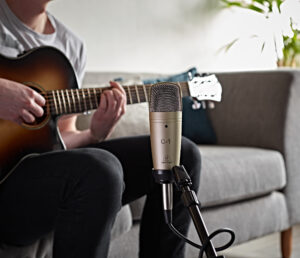
I personally own two microphones on this list – both of which are incredible for acoustic recordings. The Behringer C-1 one of them.
At just over £30, it’s earned its place in our guide!
You’ll love this mic for its exceptional detail owing to the large diaphragm condenser. This ensures all the tonal qualities from your tonewood, strings, and emotive playing are accurately represented.
The key benefit of this side-address mic is that it eliminates any low-frequency distortion thanks to a transformerless EFT input. So, you won’t get any electrical hum from your computer creeping into the mix. The cardioid polar pattern then rejects unwanted noise, whilst the larger diaphragm helps to capture a wider sound – perfect for jumbo acoustic guitar players and vocalists alike.
A built-in shock mount protects the capsule from drops or knocks and the gold-plated connection provides clarity that’s rarely seen in a mic of this price. It’s a great starting point for those looking to dabble in acoustic guitar recording.
Incredible detail, low self-noise, and inexpensive – what’s not to like?
Is this an XLR or USB mic?
The Behringer C-1 Condenser Microphone is an XLR mic – you’ll need an XLR cable and audio interface.
Shop now | Behringer C-1 Condenser Microphone
4. Tie Studio USB Large Diaphragm Condenser Mic
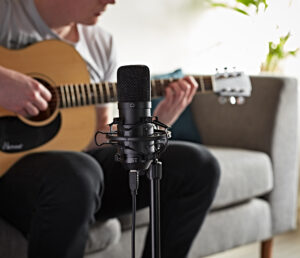 Next up, we have the Tie Studio USB Large Diaphragm Condenser Mic, pictured here in black.
Next up, we have the Tie Studio USB Large Diaphragm Condenser Mic, pictured here in black.
This is perfect for recording acoustic guitar as its sensitivity captures all the qualities of your playing. The 20Hz – 20kHz frequency response allows you to record all the lush sonic nuances of your guitar and the max SPL of 134dB means you can hit the strings hard without distortion creeping into the mix.
This is a USB condenser microphone, so you don’t need an audio interface, and it gets the phantom power through your USB connection – so there’s no need for a power amplifier.
The built-in headphone output makes it easy to monitor the mix directly through the microphone, and the large diaphragm with pop shield protects your sound against unwanted plosives.
That’s not all. The main reason this mic makes our list is its two switchable polar patterns. You have a cardioid and figure-of-eight pattern to work with.
For a more in-depth understanding, read our microphone polar patterns explained guide.
Basically, it means you can record an acoustic guitar and reject the background noise or set it to the figure-of-eight pattern and have someone singing with you on the other side – recording them at the same time. Failing that, you could set the mic to record with figure-of-eight and enjoy a “roomy” vibe whilst you play– perfect for layering and overdubbing.
This Tie Studio mic is a budget-friendly, studio-quality USB large-diaphragm microphone that won’t break the bank.
Is this an XLR or USB mic?
The Tie Studio USB Large Diaphragm Condenser Mic is a USB mic – you don’t need an XLR or an interface!
Shop now | Tie Studio USB Large Diaphragm Condenser Mic
5. Shure SM57 Dynamic Instrument Microphone
 So, I mentioned that I own two of these mics on this list – the Shure SM57 is the other. I love this mic. It’s an industry-standard dynamic instrument microphone that can record anything you want in high-quality. Pretty much every studio owner has one of these. Based on the popularity of these microphones the next person you see on the street probably owns one!
So, I mentioned that I own two of these mics on this list – the Shure SM57 is the other. I love this mic. It’s an industry-standard dynamic instrument microphone that can record anything you want in high-quality. Pretty much every studio owner has one of these. Based on the popularity of these microphones the next person you see on the street probably owns one!
Why? Because it’s a workhorse microphone that both new and old-hand studio engineers rely on to get incredible results. Kurt Cobain even recorded his vocals for Nevermind on one of these!
This cardioid mic rejects everything around it, so you get a superior, controlled recording – perfect for close mic’ing techniques. Its frequency response of 40Hz – 15kHz then makes it ideal for louder players and wider, dreadnought style guitars as it cuts out the “boom”.
Plus, a presence boost at 4kHz adds clarity and definition to your mix. You’ll hear those subtle changes in note and vibrato string bends, every time.
Best of all, you can also record vocals, drums, guitar cabs – just about anything.
Is this an XLR or USB mic?
The Shure SM57 Dynamic Instrument Microphone is an XLR mic – You’ll need an XLR cable and audio interface.
Shop now | Shure SM57 Dynamic Instrument Microphone
6. AKG P170 Project Studio Line Instrument Condenser Microphone
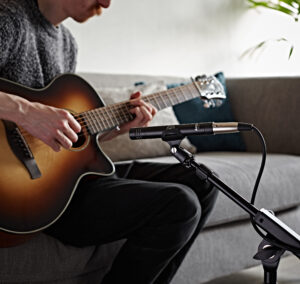 Next up, we have the AKG P170. This budget-friendly microphone comes in way under £100, yet it delivers the sonic clarity and quality of recording akin to microphones many times the price.
Next up, we have the AKG P170. This budget-friendly microphone comes in way under £100, yet it delivers the sonic clarity and quality of recording akin to microphones many times the price.
We think this is one of the best low-cost microphones for recording acoustic guitar as it provides a lot of headroom before distortion. This means you can play louder without any “crackle” creeping into the mix. And you can actually attenuate the sound by -20dB if you have a particularly heavy-handed strummer.
The 20-20,000Hz frequency response captures all the detail, while the small diaphragm and cardioid polar pattern provide a tight, controlled recording process. It’s ideal for tapping or fingerstyle players. You get all the detail you need without any surrounding noise-bleed.
The rugged, all-metal construction not only fights against sonic interference but also ensures many years of solid use, protecting the capsule from harm, should you knock or drop it.
Perfect for all manner of acoustic instruments including vocals – a good all-rounder mic that will always come in handy.
Is this an XLR or USB mic?
The AKG P170 Project Studio Line Instrument Condenser Microphone is an XLR mic – You’ll need an XLR cable and audio interface.
Shop now | AKG P170 Project Studio Line Instrument Condenser Microphone
7. SubZero SZC-300 Condenser Microphone 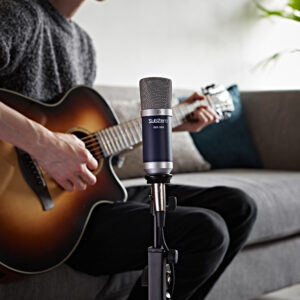
Versatile, low-cost, hard-wearing – all the qualities you need in a mic for acoustic guitars with! The SubZero SZC-300 ticks all these boxes for under £100. It provides acoustic guitar players with a side-address mic they can use for recording vocals and acoustic guitars.
Side-address mics are often better for recording acoustic guitars, and you can read why in our guide to side-address mics article.
The unidirectional cardioid polar pattern provides the clarity and concise recording experience you need, whilst the large diaphragm captures all the detail.
Its frequency response of 30Hz – 20kHz then removes all the “boom” from your recording – ideal for larger-bodied acoustic guitars – and ensures the treble is still intact without becoming overbearing.
The low distortion FET circuitry provides cleaner recording overall, whether you’re playing softly or making use of the 132dB – which is louder than a jet engine!
This mic is perfect for recording acoustic guitars, vocals, and ambient noise.
Top tip: record a silent room with this as an overdub and feel the “vibe” come alive in your mix when you overlay an acoustic guitar!
Is this an XLR or USB mic?
The SubZero SZC-300 Condenser Microphone is an XLR mic – you’ll need an XLR cable and audio interface.
Shop now | SubZero SZC-300 Condenser Microphone
8. Audio Technica AT2020 Cardioid Condenser Microphone
 We love the Audio Technica AT2020 as it’s designed for high-end studio use without the high-end price tag. At under £100, it’s perfect for recording acoustic guitars, providing an extended frequency response for detail, a cardioid polar pattern, and a unique design that makes recording easier!
We love the Audio Technica AT2020 as it’s designed for high-end studio use without the high-end price tag. At under £100, it’s perfect for recording acoustic guitars, providing an extended frequency response for detail, a cardioid polar pattern, and a unique design that makes recording easier!
This side-address mic features a fixed-charge back plate. It’s also a permanently polarised condenser that does a great job of rejecting all off-axis noise – especially behind it! The 16mm low-mass diaphragm provides a detailed, yet lively sound, bringing out the character of your guitar.
With a 20Hz – 20kHz frequency response, this is a great microphone for any style of acoustic guitar. The max SPL of 144dB is ready to handle the heaviest of players – whether you’re finger tapping, strumming, or playing a song with a percussive element, the mic can handle it.
We mentioned a unique feature… the AT2020 is a side-address mic, which can sometimes be awkward to place, depending on how much room you have to record in. This mic solves that problem. It includes a pivoting threaded stand mount that attaches easily to your microphone stand, making it easy to set up – no matter how you sit or stand when playing.
We also recommend reading our how to record guitar article to get the best results from a mic like this as a little education on placement can really bring your recordings to life!
Is this an XLR or USB mic?
The Audio Technica AT2020 Cardioid Condenser Microphone is an XLR mic – you’ll need an XLR cable and audio interface.
Shop now | Audio Technica AT2020 Cardioid Condenser Microphone
9. SubZero SZC-100 Pencil Condenser Microphone, Pair
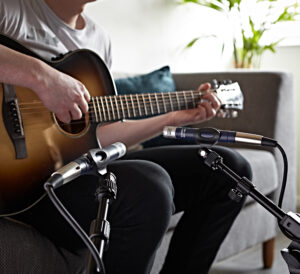 Last but not least we have the SubZero SZC-100. This package contains two microphones for the price of one and still fits in the sub £100 price range.
Last but not least we have the SubZero SZC-100. This package contains two microphones for the price of one and still fits in the sub £100 price range.
If you want to capture all aspects of your acoustic guitar, including the tonewoods, chord slides, quality of strings, and the “feel” of your sound, XY or stereo recording techniques are ideal. These are where you record with two condenser mics at the same time – ideally pencil mics, which these are!
This pair of condenser mics are matched, which means you don’t get an out-of-phase, thin sound when recording and the true condenser, cardioid polar pattern rejects all the background noise. It’s like recording in a professional studio for less than £100!
You also have a wide frequency range of 30Hz-18kHz to capture the nuances of your playing without the boom or top-end shrill that can sometimes creep in. This is ideal for all types of acoustic guitar, especially if you have heavier gauge strings. All the bass – no unwanted boom.
They are also perfect for recording drum overheads, vocals, and ambient room noise – or why not record two guitars at the same time? The SZC-100 pair won’t break the bank. They’re easily some of the best microphones for recording acoustic guitar under £100.
Closing thoughts
We hope you enjoyed our article on the best mics under £100 for recording acoustic guitar. One thing to bear in mind when choosing your microphone is that you want as much detail as possible, without having to deal with unwanted frequencies.
So, we always recommend taking into account your style of playing, your guitar size, and your needs when choosing a mic. Try and get a mic that’s reliable, hardwearing, and sensitive and you’ll find they last you for many years.
Let us know in the comments below if you have any tips for finding the best acoustic guitar mic with a price tag lower than £100! We love to hear back from our readers.

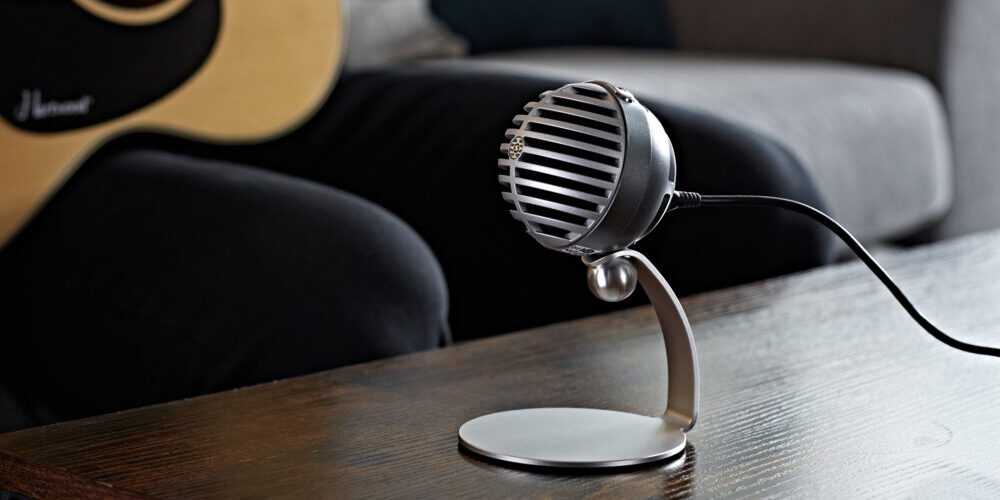











0 Comments